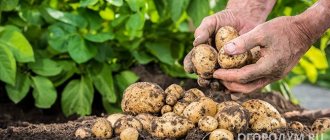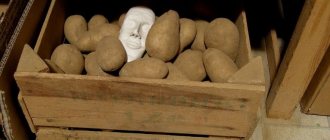Timing for harvesting potatoes for winter storage
Well-ripened potatoes can be stored for a long time. If it is harvested early, it will be difficult to preserve the harvest. How to determine the time to harvest potatoes? As a rule, harvesting of varieties intended for winter storage is scheduled for late August-early September. Root crops ripen 10 days before harvesting. You will notice the beginning of the process by the drying tops. Dig up a few potato bushes in mid-August and see how the skins peel off. The skin of unripe tubers is easily peeled off. For those ready to harvest, it’s difficult.
To speed up ripening, mow the tops 1-2 weeks before harvesting and leave the crop on the field until it finally ripens. The skin of the root crop will become rough and the eyes will fully form. The quality of the crop will improve, the accumulated starch and other valuable substances will give the potatoes a varietal taste, aroma, and properties. For long-term storage, potato varieties of medium and late ripeness are used. The middle ones are harvested starting from the first weeks of August, the late ones - from the end of August to mid-September. In autumn, the rainy period begins, so these dates are the most optimal. By staying in the ground longer during the rainy season, potatoes absorb a lot of moisture and their shelf life will decrease. If it is dry, on the contrary, it dries out and withers. A sunny day is chosen for harvesting potatoes. After the tubers are dug up, they begin preparing them for storage.
Preparing potatoes for storage
After harvesting, the period of preparing tubers for storage begins. At this time you will need to solve the following problems:
- sort root vegetables
- discard the affected ones,
- place in a treated container and take it indoors.
After digging up the potatoes, prepare them for storage in the following sequence:
- Leave it in the sun (for 2-3 hours). It will dry out, and the ultraviolet rays of the sun will reduce the rate of spread of fungal infection and protect against the early appearance of sprouts.
- Carefully clean the tubers from the soil, sort them by purpose: medium size (like a small egg) - for planting next year.
- large ones - for eating
- small ones - for pet food.
Now potatoes can be stored in a cellar or a specially equipped basement.
Ideal storage environment for potatoes
To preserve potatoes for a long time, it is necessary to provide the crop with appropriate conditions:
- Correct temperature regime: the temperature should be from +2°C to +4°C. If the temperature is lower, the process of converting starch into sugar occurs; if it is higher, sprouts will begin to appear on the potatoes. To maintain a stable regime, install a thermometer in the cellar and systematically monitor changes. When the temperature rises, turn on the ventilation, open additional air vents; when the temperature drops, cover it and turn on heating devices.
- Air humidity for storage should be between 70-85%. There are also special devices for measuring humidity levels - hygrometers. Turn on ventilation when the humidity percentage increases, prevent the development of fungal diseases and increased rotting of root crops. To combat excess moisture, cover the cellar floor with quartz sand and pebbles - materials that absorb moisture.
- Experts advise laying a layer of beets on top of the potatoes (they absorb moisture well).
- Vermiculite sprinkled in a layer of 3-4 cm will reduce the % humidity.
Growing conditions
Only healthy root vegetables can be stored
Before storing vegetables in the cellar, you need to take into account the conditions in which they were grown:
- soil type;
- amount of precipitation;
- presence of diseases;
- potassium and nitrogen content in the soil.
Even if the optimal temperature for storing potatoes is maintained in the basement, if the rules of agricultural technology are not followed, it will be meaningless. During the rainy season, the shelf life of potatoes decreases steadily by 50%, they become watery and lose their taste. Vegetables grown on fertile or sandy loam soils will be stored much better. Applying a sufficient amount of potassium and nitrogen fertilizers allows you to obtain a crop with high shelf life.
Another important factor that affects the safety of potatoes is all kinds of diseases and pest damage. Moreover, even careful sorting of root crops does not guarantee the identification of all infected fruits. Many fungal spores and pathological microorganisms that cause viral diseases can persist in tubers for a long time without manifesting themselves.
What varieties of potatoes are best stored?
The keeping quality of potatoes depends on the starch content in it. A more stable product has a higher content of the substance. Potatoes that are yellow in the middle also store well. For winter storage, medium and late varieties are preferable. There are many such varieties. For example, Nevsky, Skarb, Slavyanka. If storage problems arise, choose varieties that are resistant to various diseases.
Early potatoes are not used for winter storage. They try to use it before November. Early potato varieties “Hozyayushka” and “Aurora” are stored for up to three months. Early potatoes are also stored for planting. There are varieties that are poorly stored and begin to rot: “Sineglazka”, “Dnepryanka”. They should be used as early as possible.
On the balcony
If the balcony is not insulated, keep potatoes only in insulated boxes so that the vegetables are not spoiled by cold and temperature fluctuations. In cold weather, it is necessary to additionally insulate - with blankets or polystyrene foam. You can leave potatoes in ordinary boxes, but only when the temperature does not drop to 0 °C or below.
It is not difficult to store potatoes at home - you only need a temperature of +2...+4 ˚C, humidity 80-90%, good ventilation and darkness. Under these conditions, potatoes of late varieties can last up to 10 months. But it must be sorted regularly, since just 1 spoiled potato can ruin the entire vegetable supply.
Potato storage areas
At the dacha, potatoes are usually stored in an equipped cellar or vegetable pit. City residents who take part of the harvest home are sometimes forced to use places that are poorly suited for the role of storing vegetables - balconies, corridors, storage rooms. What if summer residents grow large quantities of vegetables for sale? We recommend vegetable storage. Regulation of temperature, humidity, and organization of ventilation in them occurs automatically. Select rotten and damaged vegetables - and you can look for a place in a paid storage facility.
Storing potatoes in the cellar
A cool, dry cellar is perfect for storing small amounts of potatoes. The underground room maintains a constant temperature almost all the time. When choosing a cellar for storage, listen to the advice of experts:
- The cellar floor cannot be cemented or covered with any type of coating - linoleum, boards. The environment will be damp and mold will appear.
- Prepare the room for storing the crop: disinfect it in one of the following ways: Burn a lump of sulfur or a sulfur bomb in the cellar.
- Using a sprayer, treat with a 5% solution of bleach and copper sulfate.
- Treat twice with an interval of 7-10 days with a special composition. To prepare it, dissolve the ingredients in a bucket of water: Table salt – 150 g.
- Slaked lime – 2 kg,
- Copper sulfate -1 kg.
For storage, choose suitable containers:
- Plastic, wooden boxes for 10-12 kg of product. These open-top containers with lattice walls provide good breathability. The boxes can be moved from place to place without much difficulty and placed on racks and shelves. When installing boxes, you should leave a distance of 15-20 cm from the cellar wall, and at least half a meter from the ceiling. Install the boxes so that there is a distance of 10 cm between them.
- Mesh bags are convenient for storing vegetables. You can examine all the potatoes, see those affected by rot, frozen, and reject them in time.
- Canvas bags. They can hold 25 kg of vegetables. They will need to be carefully placed on top of each other in a pile, taking into account that too much weight can affect the safety of the potatoes.
- Use polypropylene bags only for transportation: oxygen access is limited in them.
- Double fine mesh wire mesh. They are used in conditions of high risk of rodent infestation.
- An iron barrel with small holes for air permeability, closed on top with an iron mesh
- In a mound in a fenced off corner. The height of the potato mound should not be higher than one and a half meters.
- A 4x4 meter hole dug in a dry area. At the first frost, potatoes are placed there. Place dry straw at the bottom of the hole. Sand, crushed stone 20-30 cm high, and earth 20-25 cm (in the form of a mound) should be poured on top. Place branches on the mound to protect against rodents.
Place a few apples in the box; they will slow down the germination of potatoes. You can cover the crop with a cotton rag or burlap. They will not worsen air exchange, but will protect the crop in unforeseen situations - during a sudden, severe cold snap.
Storing potatoes in the hallway or entrance
Where can you store potatoes even for a short time if you don’t have a balcony? Storing potatoes in the hallway or entryway is a better way than simply storing them in the apartment. It's a little cooler here and there's better breathability. The smell of potatoes is practically not noticeable. The temperature in the heated corridor does not reach the required temperature, but sometimes approaches it. How long can crops be stored in such conditions? Within three months after harvesting, the vital activity of potatoes is reduced; they do not germinate even at room temperature. In January, the sprouting of the eyes will begin and a noticeable smell of potatoes will appear. Of course, it is impossible to keep vegetables in such conditions for a long time: they will wither, sprout, and rot. There is no need to insulate containers for vegetables - a regular box will do. The main thing is that there is no access to light.
Storing potatoes on the balcony
Summer residents often bring part of the harvest to their apartment for storage on the balcony. They put food in bags and boxes. And at low temperatures in winter, they cover the containers with fur coats and coats, and bring them into a heated room for a while. Of course, it is difficult to create a suitable temperature regime for storing crops in such conditions. For heating, a 40 W blue lamp is used.
- A more effective option seems to be storing tubers in special wooden containers-boxes, which, as a rule, have double walls, a bottom, and a lid. The distance between the walls is from 4 to 6 cm, it should be filled with insulation: polystyrene foam (sawdust, shavings). Disinfection of the box: 4% bleach, 1% solution of copper sulfate. The box will need to be treated (for example, paint) to protect it from moisture.
- The boxes can be equipped with an electric heating system that has a thermostat for temperature correction. The dimensions of the containers depend on the area of the place where the products are stored.
- The thermal container is offered by a retail chain. It is made of thick canvas fabric. It is a double bag. The distance between the containers is filled with insulation - padding polyester. It can also be equipped with a heating system and temperature controller. Preserves potatoes at an outside temperature of -40.
In the created conditions, it is possible to maintain the required temperature, and the shelf life of vegetables is extended until spring. But there is a high possibility of food freezing, drying out, and rotting due to temperature changes and lack of ventilation. You will need to protect the vegetables from light. Sprinkle root vegetables with ash and onion peels to reduce moisture.
Storing potatoes in the refrigerator
Small quantities of potatoes can be stored in paper bags in a household refrigerator. In the refrigerator, a temperature regime suitable for storage has been created. Why can't we put in a large volume of crops?
- Not enough space.
- The humidity of the refrigerator sometimes contributes to the spoilage of the product; with sufficient air access, over time the smell of potatoes will appear in the refrigerator.
Based on the experience of summer residents, we can state that the maximum shelf life of vegetables is about two weeks. It is possible to store potatoes for a long time in a separate special refrigerator. There the required temperature is set using a thermostat. You don't need to do anything else. Unfortunately, the cost of such a camera is not affordable for everyone.
Storing potatoes in an apartment
Before connecting central heating (until November), you can safely store potatoes in the apartment. A month after harvesting, the vegetables will not germinate and there will be no strong smell. When the heating is turned on, the temperature in the apartment will rise to 20°C. Uncomfortable conditions will be everywhere - in the corridor near the front door, in the closet, near the balcony door. In such conditions, potatoes can be preserved for a week or two, then they will begin to rot and wither.
Basic rules for storing potatoes
- When buying vegetables for storage, choose one variety.
- Carry out systematic culling of affected tubers.
- Store potatoes of medium and late ripeness varieties.
- In the cellar, different varieties should be stored in different containers. Keep seed potatoes separately.
- Place sand and sawdust at the bottom of the boxes - they will absorb moisture.
- Provide adequate temperature and ventilation.
- Clean and disinfect the area and containers before planting the crop.
- For storage, use small containers, up to 15 kg.
Follow the storage rules and you will preserve the entire potato harvest.
0 0 vote
Article rating
In the garage
Garages with a cellar are a good option for storage; in this case, the subfloor is treated in the same way as a basement in a house. But if it is missing, then it is also acceptable to keep potatoes in this room, the main thing is to properly organize the space:
- To prevent temperature fluctuations, thermometers and heaters are installed - frost can spoil vegetables.
- The tubers are covered with breathable material - this will protect them from high humidity and light.
- The garage is cleaned, treated with disinfectants and ventilated.
- Store the fruits in ventilated wooden containers or bags and regularly sort through them, throwing out spoiled specimens.
On a note! If the volume is small, then a heat box is a good option for an unheated garage.











